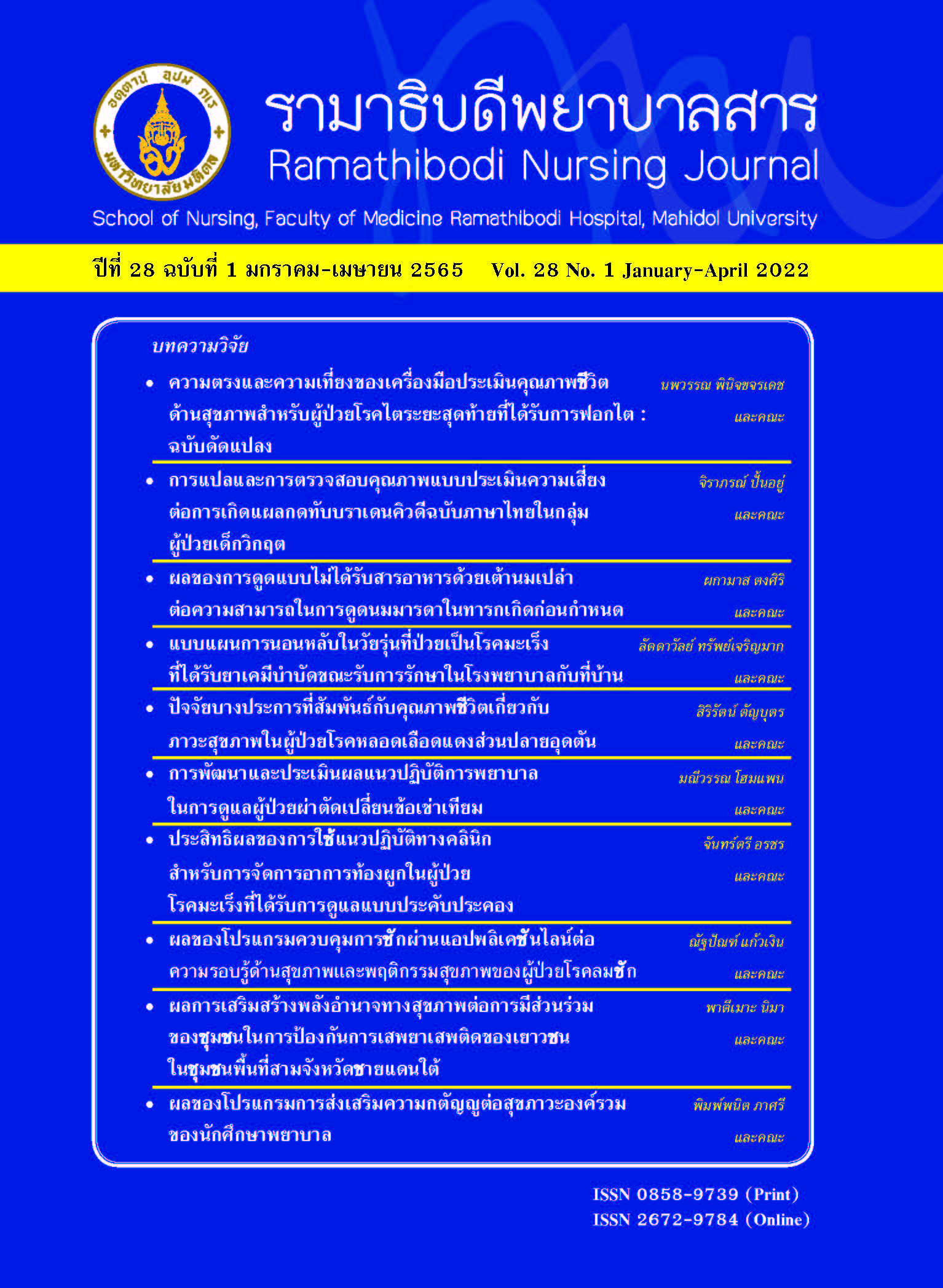Translation and Validation of the Braden QD Scale (Thai version) for Predicting Pediatric Pressure Injury Risk in Pediatric Critically Ill Patients
Main Article Content
Abstract
This study aimed to translate the Braden QD scale for predicting pediatric pressure injury risk from the original English version into the Thai version and validate the reliability of the Braden QD scale (Thai version) in critically ill patients admitted to the pediatric intensive care unit. This study was divided into Phase I: a translation process and verification, and Phase II: a testing process with critically ill pediatric patients.The sample consisted of 85 critically ill pediatric patients, aged one month to 18 years,admitted to the Pediatric Intensive Care Unit at Ramathibodi Hospital and met inclusion criteria. They were divided into ten patients for the first phase and 75 patients for the second phase. The interrater reliability and concurrent validity were used to determine psychometric properties of the Braden QD scale (Thai version). The result revealed a high intraclass correlation coefficient (ICC) between the Braden QD scale (Thai version)and the Braden Q scale. For the concurrent validity when the Braden Q scale was used as the reference, the correlation between the scores on the Braden QD scale (Thai version)and those on the Braden Q scale was significantly moderate and negative when the scores were reversed to obtain the same meaning. Hence, the Braden QD Scale (Thai version)is an acceptable tool to assess pressure injury risk in critically ill pediatric patients.
Keywords: Translation, Validity, Reliability, the Braden QD Scale (Thai version),Critically ill pediatric patients
Article Details

This work is licensed under a Creative Commons Attribution-NonCommercial-NoDerivatives 4.0 International License.
บทความ ข้อมูล เนื้อหา รูปภาพ ฯลฯ ที่ได้รับการตีพิมพ์ในรามาธิบดีพยาบาลสาร ถือเป็นลิขสิทธิ์ของวารสาร หากบุคคลหรือหน่วยงานใดต้องการนำทั้งหมดหรือส่วนหนึ่งส่วนใดไปเผยแพร่หรือเพื่อกระทำการใด ใด จะต้องได้รับอนุญาตเป็นลายลักษณ์อักษรจากรามาธิบดีพยาบาลสารก่อนเท่านั้น
References
Delmore B, Deppisch M, Sylvia C, Luna-Anderson C,Nie AM. Pressure injuries in the pediatric population: a National Pressure Ulcer Advisory Panel white paper. Adv Skin Wound Care. 2019;32(9):394-408.
Noonan C, Quigley S, Curley MA. Skin integrity in hospitalized infants and children: a prevalence survey. J Pediatr Nurs. 2006;21(6):445-53. doi: 10.1016/j.pedn.2006.07.002
Murray JS, Noonan C, Quigley S, Curley MA. Medical device-related hospital-acquired pressure ulcers in
children: an integrative review. J Pediatr Nurs.2013;28(6):585-95.
Anthony D. What do we know about paediatric pressure ulcer risk assessment? Wounds UK. 2017;13(1):28-31.
McLane KM, Bookout K, McCord S, McCain J, Jefferson LS. The 2003 national pediatric pressure ulcer and skin breakdown prevalence survey: a multisite study. J Wound Ostomy Continence Nurs. 2004;31(4):168-78.
Schlüer A-B, Schols JM, Halfens RJ. Pressure ulcer treatment in pediatric patients. Adv Skin Wound Care.2013;26(11):504-10.
Curley MA, Quigley SM, Lin M. Pressure ulcers in pediatric intensive care: incidence and associated factors.Pediatr Crit Care Med. 2003;4(3):284-90.
Visscher M, King A, Nie AM, Schaffer P, Taylor T, Pruitt D, et al. A quality-improvement collaborative project to reduce pressure ulcers in PICUs. Pediatrics.2013;131(6):e1950-e60.
Chamblee T B, Pasek TA, Caillouette CN, Stellar JJ,Quigley SM, Curley MA. CE: how to predict pediatric pressure injury risk with the Braden QD Scale. Am J Nurs.2018;118(11):34-43.
Curley MA, Hasbani NR, Quigley SM, Stellar JJ, Pasek TA, Shelley SS, et al. Predicting pressure injury risk in pediatric patients: the Braden QD Scale. J Pediatr.2018;192:189-95.
Puspitasari JD, Nurhaeni N, Waluyanti FT. Testing of Braden QD Scale for predicting pressure ulcer risk in the pediatric intensive care Unit. Pediatr Rep. 2020;12(11):15-7.
Sawasdipanich N, Tiansawad S. Instrument translation for cross-cultural research: technique and issues to be considered. Thai Journal of Nursing Council.2011;26(1):19-28. (in Thai).
National Pressure Ulcer Advisory Panel (NPUAP).Pressure injury staging system 2016. Available from:https://npiap.com/page/PressureInjuryStages
Bergstrom N, Braden BJ, Laguzza A, Holman V. The Braden scale for predicting pressure sore risk. Nurs Res.1987;36(4):205-10.
Nunnally JC. Psychometric theory. New York: McGraw-Hill; 1978.
Curley MA, Razmus IS, Roberts KE, Wypij D. Predicting pressure ulcer risk in pediatric patients: The Braden Q Scale. Nurs Res. 2003;52(1):22-33.
Brislin RW. Back-translation for cross-cultural research.J Cross Cult Psychol. 1970;1(3):185-216.
Polit DF, Beck CT, Owen SV. Is the CVI an acceptable indicator of content validity? Appraisal and recommendations. Res Nurs Health. 2007;30(4):459-67. doi: 10.1002/nur.20199
Waltz CF, Strickland OL, Lenz ER. Measurement in nursing and health research. 3 ed. New York: Springer Publishing Company; 2005.
Shrout PE, Fleiss JL. Intraclass correlations: uses in assessing rater reliability. Psychol Bull. 1979;86(2):420-8.
Lauderbaugh DL, Billman G, Popien TL, Hauseur S, Lee E, O’Haver J. A comparison of the Braden Q and the Braden QD scale to assess pediatric risk for pressure injuries during noninvasive ventilation. Respir Care.2021;66(8):1234-9. doi: 10.4187/respcare.08536


